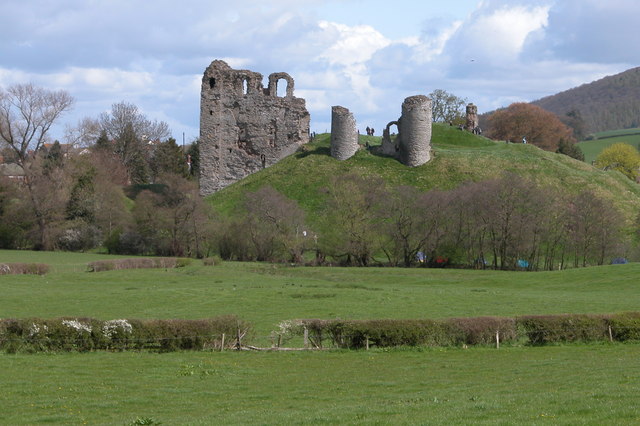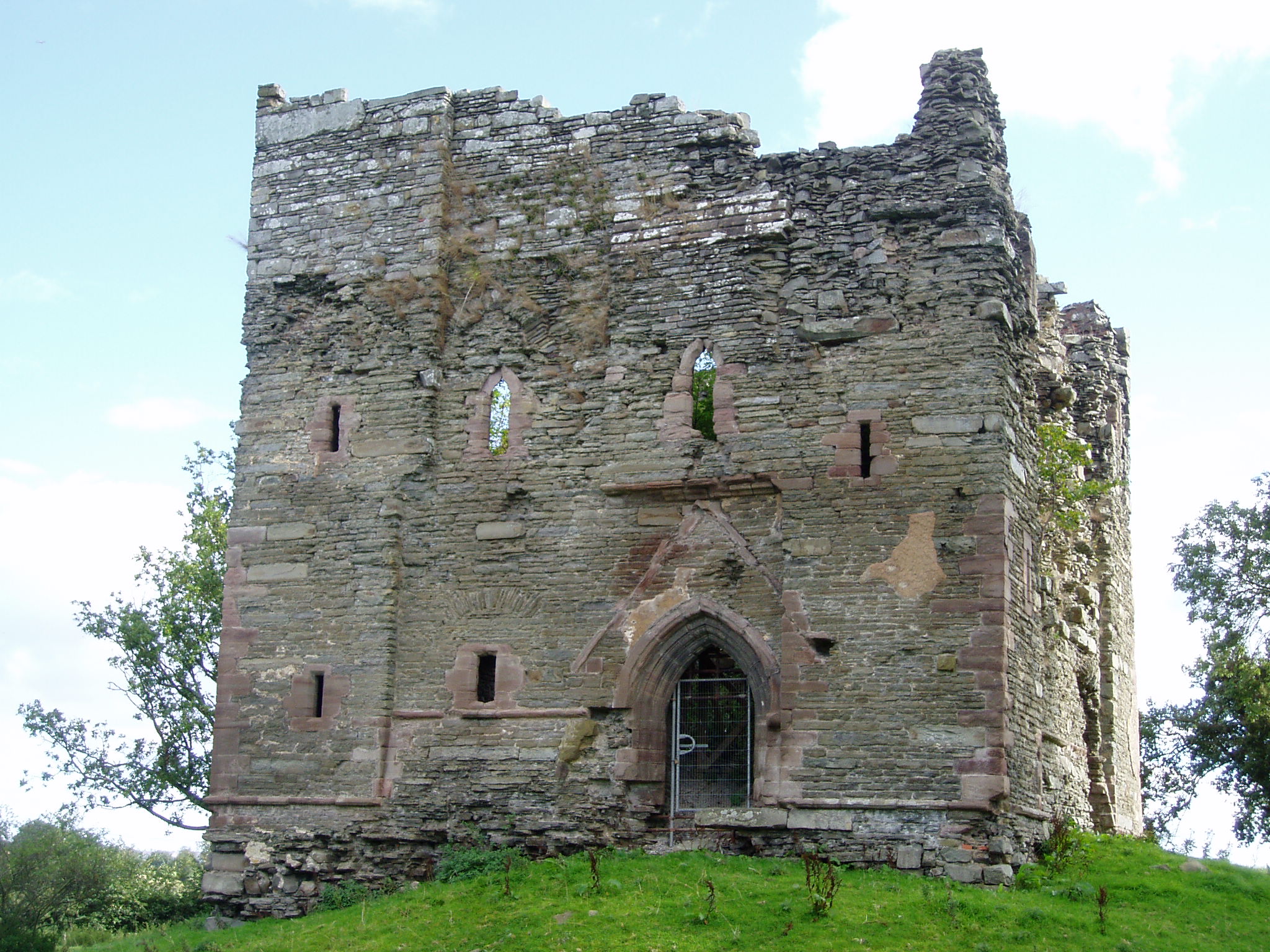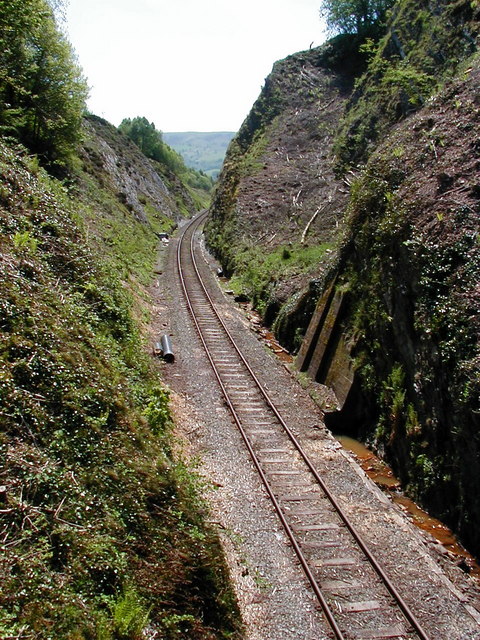|
Clun Castle
Clun Castle is a medieval ruined castle in Clun, Shropshire, England. Clun Castle was established by the Norman lord Robert de Say after the Norman invasion of England and went on to become an important Marcher lord castle in the 12th century, with an extensive castle-guard system. Owned for many years by the Fitzalan family, Clun played a key part in protecting the region from Welsh attack until it was gradually abandoned as a property in favour of the more luxurious Arundel Castle. The Fitzalans converted Clun Castle into a hunting lodge in the 14th century, complete with pleasure gardens, but by the 16th century the castle was largely ruined. Slighted in 1646 after the English Civil War, Clun remained in poor condition until renovation work in the 1890s. Today the castle is classed as a Grade I listed building and as a Scheduled Monument. It is owned by the Duke of Norfolk, who also holds the title of Baron Clun, and is managed by English Heritage. Architecture Clun Castle ... [...More Info...] [...Related Items...] OR: [Wikipedia] [Google] [Baidu] |
Shropshire
Shropshire (; alternatively Salop; abbreviated in print only as Shrops; demonym Salopian ) is a landlocked historic county in the West Midlands region of England. It is bordered by Wales to the west and the English counties of Cheshire to the north, Staffordshire to the east, Worcestershire to the southeast, and Herefordshire to the south. A unitary authority of the same name was created in 2009, taking over from the previous county council and five district councils, now governed by Shropshire Council. The borough of Telford and Wrekin has been a separate unitary authority since 1998, but remains part of the ceremonial county. The county's population and economy is centred on five towns: the county town of Shrewsbury, which is culturally and historically important and close to the centre of the county; Telford, which was founded as a new town in the east which was constructed around a number of older towns, most notably Wellington, Dawley and Madeley, which is today th ... [...More Info...] [...Related Items...] OR: [Wikipedia] [Google] [Baidu] |
Scheduled Monument
In the United Kingdom, a scheduled monument is a nationally important archaeological site or historic building, given protection against unauthorised change. The various pieces of legislation that legally protect heritage assets from damage and destruction are grouped under the term "designation." The protection provided to scheduled monuments is given under the Ancient Monuments and Archaeological Areas Act 1979, which is a different law from that used for listed buildings (which fall within the town and country planning system). A heritage asset is a part of the historic environment that is valued because of its historic, archaeological, architectural or artistic interest. Only some of these are judged to be important enough to have extra legal protection through designation. There are about 20,000 scheduled monuments in England representing about 37,000 heritage assets. Of the tens of thousands of scheduled monuments in the UK, most are inconspicuous archaeological sites, but ... [...More Info...] [...Related Items...] OR: [Wikipedia] [Google] [Baidu] |
Arrowslit
An arrowslit (often also referred to as an arrow loop, loophole or loop hole, and sometimes a balistraria) is a narrow vertical aperture in a fortification through which an archer can launch arrows or a crossbowman can launch bolts. The interior walls behind an arrow loop are often cut away at an oblique angle so that the archer has a wide field of view and field of fire. Arrow slits come in a variety of forms. A common one is the cross, accommodating the use of both the longbow and the crossbow. The narrow vertical aperture permits the archer large degrees of freedom to vary the elevation and direction of their bowshot, but makes it difficult for attackers to harm the archer since there is only a small target at which to aim. Balistraria, plural balistrariae, from balister, crossbowman can often be found in the curtain walls of medieval battlements beneath the crenellations. History The invention of the arrowslit is attributed to Archimedes during the siege of Syracuse in 2 ... [...More Info...] [...Related Items...] OR: [Wikipedia] [Google] [Baidu] |
Guildford Castle
Guildford Castle is in Guildford, Surrey, England. It is thought to have been built by William the Conqueror, or one of his barons, shortly after the 1066 invasion of England. History From the eleventh to the thirteenth century Construction and development After the Battle of Hastings in 1066 William led his army to Canterbury and then sacked towns along the Pilgrims' Way, including Guildford. Later William, or one of his barons, built Guildford Castle. There is no record of it in the Domesday Book so construction probably started after 1086. First to be built at the Castle would have been the motte (a mound) around which was a ditch and a bailey protected by a wooden palisade. The bailey's boundary would have run along Castle Street, South Hill, what is now Racks Close and parallel with Quarry Street (although slightly to the east). If it followed a typical Norman design the bailey would have been divided with a palisade, into two parts the outer and inner bail. The inner ... [...More Info...] [...Related Items...] OR: [Wikipedia] [Google] [Baidu] |
Buttress
A buttress is an architectural structure built against or projecting from a wall which serves to support or reinforce the wall. Buttresses are fairly common on more ancient buildings, as a means of providing support to act against the lateral (sideways) forces arising out of inadequately braced roof structures. The term ''counterfort'' can be synonymous with buttress and is often used when referring to dams, retaining walls and other structures holding back earth. Early examples of buttresses are found on the Eanna Temple (ancient Uruk), dating to as early as the 4th millennium BC. Terminology In addition to flying and ordinary buttresses, brick and masonry buttresses that support wall corners can be classified according to their ground plan. A clasping or clamped buttress has an L shaped ground plan surrounding the corner, an angled buttress has two buttresses meeting at the corner, a setback buttress is similar to an angled buttress but the buttresses are set back from the ... [...More Info...] [...Related Items...] OR: [Wikipedia] [Google] [Baidu] |
Pilaster
In classical architecture Classical architecture usually denotes architecture which is more or less consciously derived from the principles of Greek and Roman architecture of classical antiquity, or sometimes even more specifically, from the works of the Roman architect V ..., a pilaster is an :Architectural elements, architectural element used to give the appearance of a supporting column and to articulate an extent of wall, with only an ornamental function. It consists of a flat surface raised from the main wall surface, usually treated as though it were a column, with a Capital (architecture), capital at the top, plinth (base) at the bottom, and the various other column elements. In contrast to a pilaster, an engaged column or buttress can support the structure of a wall and roof above. In human anatomy, a pilaster is a ridge that extends vertically across the femur, which is unique to modern humans. Its structural function is unclear. Definition In discussing Leon Battis ... [...More Info...] [...Related Items...] OR: [Wikipedia] [Google] [Baidu] |
Hopton Castle
Hopton Castle is situated in the village of the same name which lies approximately halfway between Knighton and Craven Arms, in the English county of Shropshire. Hopton Castle featured in the British TV series ''Time Team'' in 2010. A ruin since the early 18th century, it was partially restored between 2006 and 2011, and was officially re-opened to the public as a visitor attraction in December 2011 by the Duke of Gloucester. Norman castle The castle may have been founded in the 12th century as a motte and bailey by one of the Hoptons as a mesne lord of the Says of Clun Castle. Walter de Hopton possibly built the stone castle during the Barons' War of the 1260s. The bailey was fortified in stone and a rectangular two-storey keep was built. The last Walter Hopton died during the Wars of the Roses and the castle passed by marriage to the Corbet family of Moreton Corbet castle. From them it passed to Henry Wallop (died 1642) when he married Elizabeth Corbet, daughter of Robert ... [...More Info...] [...Related Items...] OR: [Wikipedia] [Google] [Baidu] |
Bridgnorth Castle
Bridgnorth Castle is a castle in the town of Bridgnorth, Shropshire. It is a scheduled monument, first listed in 1928. History 12th century The castle was founded in 1101 by Robert de Belleme, the son of the French Earl, Roger de Montgomery, who succeeded his father as Earl of Shrewsbury, possibly on the site of a Saxon burh built by Æthelflæd in 912. One year later in 1102, King Henry I took control of the castle from Robert de Belleme and Henry built another temporary castle on Panpudding Hill. Much of the outer building, which consists of shattered walls, dates to a period of construction that is believed to have occurred between 1105-1113. Around 1120, Henry I re-plastered the walls of the castle and replaced them with better quality stone. Its principal feature, a square great tower, was built during the reign of Henry II in 1160 and the castle was extended between 1166-1174. In the early 1200s construction to extend the castle continued. 13th-16th centuries A turret or ... [...More Info...] [...Related Items...] OR: [Wikipedia] [Google] [Baidu] |
Alberbury Castle
Alberbury Castle is in the village of Alberbury, some nine miles west of Shrewsbury, Shropshire and very close to the border with Wales. The building has been constructed from locally available red sandstone. It is a Grade II listed building. Its origins are uncertain but it was probably built in the 13th century by Fulk FitzWarin during the reign of Richard I. According to Sir William Dugdale, the castle of Alberbury was given to Guarine de Metz, the ancestor of FitzWarin family, by William the Conqueror. However, this account is disputed by the Domesday book. The main purpose of its construction appears to have been as a barrier to stop the Welsh onslaught and to retain control of the passes along the River Severn. According to sources, the castle was razed by Llewellyn the Great in 1223, only to be rebuilt three years later in 1226, this time with a stone wall surrounding the bailey. A few years later, the Sheriff of Shropshire, Thomas Corbet of Caus, took advantage of a ... [...More Info...] [...Related Items...] OR: [Wikipedia] [Google] [Baidu] |
Keep
A keep (from the Middle English ''kype'') is a type of fortified tower built within castles during the Middle Ages by European nobility. Scholars have debated the scope of the word ''keep'', but usually consider it to refer to large towers in castles that were fortified residences, used as a refuge of last resort should the rest of the castle fall to an adversary. The first keeps were made of timber and formed a key part of the motte-and-bailey castles that emerged in Normandy and Anjou during the 10th century; the design spread to England, south Italy and Sicily. As a result of the Norman invasion of 1066, use spread into Wales during the second half of the 11th century and into Ireland in the 1170s. The Anglo-Normans and French rulers began to build stone keeps during the 10th and 11th centuries; these included Norman keeps, with a square or rectangular design, and circular shell keeps. Stone keeps carried considerable political as well as military importance and could take up ... [...More Info...] [...Related Items...] OR: [Wikipedia] [Google] [Baidu] |
Counterscarp
A scarp and a counterscarp are the inner and outer sides, respectively, of a ditch or moat used in fortifications. Attackers (if they have not bridged the ditch) must descend the counterscarp and ascend the scarp. In permanent fortifications the scarp and counterscarp may be encased in stone. In less permanent fortifications, the counterscarp may be lined with paling fence set at an angle so as to give no cover to the attackers but to make advancing and retreating more difficult. If an attacker succeeds in breaching a wall a coupure can be dug on the inside of the wall to hinder the forlorn hope, in which case the side of the ditch farthest from the breached wall and closest to the centre of the fortification is also called the counterscarp. Counterscarp gallery These are tunnels or "galleries" that have been built behind the counterscarp wall inside the moat or ditch. Each gallery is pierced with loopholes for musketry, so that attacking forces that enter the moat can be dire ... [...More Info...] [...Related Items...] OR: [Wikipedia] [Google] [Baidu] |
Cut (earthmoving)
In civil engineering, a cut or cutting is where soil or rock from a relative rise along a route is removed. The term is also used in river management to speed a waterway's flow by short-cutting a meander. Cuts are typically used in road, rail, and canal construction to reduce the length and grade of a route. Cut and fill construction uses the spoils from cuts to fill in defiles to cost-effectively create relatively straight routes at steady grades. Cuts are used as alternatives to indirect routes, embankments, or viaducts. They also have the advantage of comparatively lower noise pollution than elevated or at-grade solutions. History The term ''cutting'' appears in the 19th century literature to designate rock cuts developed to moderate grades of railway lines. ''Railway Age's Comprehensive Railroad Dictionary'' defines a cut as "a passage cut for the roadway through an obstacle of rock or dirt." Creation Cuts can be created by multiple passes of a shovel, grader, scrap ... [...More Info...] [...Related Items...] OR: [Wikipedia] [Google] [Baidu] |


.jpg)
.jpg)




